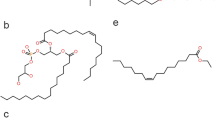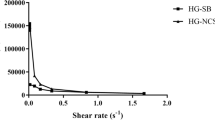Abstract
Emulsions are widely used as topical formulations in the pharmaceutical and cosmetic industries. They are thermodynamically unstable and require emulsifiers for stabilization. Studies have indicated that emulsifiers could affect topical delivery of actives, and this study was therefore designed to investigate the effects of different polymers, applied as emulsifiers, as well as the effects of pH on the release and topical delivery of the active. O/w emulsions were prepared by the layer-by-layer technique, with whey protein forming the first layer around the oil droplets, while either chitosan or carrageenan was subsequently adsorbed to the protein at the interface. Additionally, the emulsions were prepared at three different pH values to introduce different charges to the polymers. The active ingredient, salicylic acid, was incorporated into the oil phase of the emulsions. Physical characterization of the resulting formulations, i.e., droplet size, zeta potential, stability, and turbidity in the water phase, was performed. Release studies were conducted, after which skin absorption studies were performed on the five most stable emulsions, by using Franz type diffusion cells and utilizing human, abdominal skin membranes. It was found that an increase in emulsion droplet charge could negatively affect the release of salicylic acid from these formulations. Contrary, positively charged emulsion droplets were found to enhance dermal and transdermal delivery of salicylic acid from emulsions. It was hypothesized that electrostatic complex formation between the emulsifier and salicylic acid could affect its release, whereas electrostatic interaction between the emulsion droplets and skin could influence dermal/transdermal delivery of the active.






Similar content being viewed by others
REFERENCES
Förster T, Von Rybinski W. Applications of emulsions. In: Binks BP, editor. Modern aspects of emulsion science. Cambridge: Royal Society of Chemistry; 1998. p. 395–426.
Youenang Piemi MP, Korner D, Benita S, Marty JP. Positively and negatively charged submicron emulsions for enhanced topical delivery of antifungal drugs. J Control Release. 1999;58:177–87.
Frelichowska J, Bolzinger MA, Valour JP, Mouaziz H, Pelletier J, Chevalier Y. Pickering w/o emulsions: drug release and topical delivery. Int J Pharm. 2009;368:7–15.
Förster M, Bolzinger MA, Ach D, Montagnac G, Briancon S. Ingredients tracking of cosmetic formulations in the skin: a confocal Raman microscopy investigation. Pharm Res. 2011;28:858–72.
Oborska A, Arct J, Mojski M, Jaremko E. Influence of polyalcohols and surfactants on skin penetration of flavonoids from the emulsion. J Appl Cosmetol. 2004;22:35–42.
Dalvi UG, Zatz JL. Effect of nonionic surfactants on penetration of dissolved benzocaine through hairless mouse skin. J Soc Cosmet Chem. 1981;32:87–94.
McClements DJ. Structural design principles for improved food performance: nanolaminated biopolymer structures in foods. In: Huang Q, Given P, Qian M, editors. Micro/nanoencapsulation of active food ingredients. ACS Symposium Series 1007. Washington, DC: American Chemical Society; 2009. p. 3–34.
Cho YH, Decker EA, McClements DJ. Competitive adsorption of mixed anionic polysaccharides at the surfaces of protein-coated lipid droplets. Langmuir. 2009;25:2654–60.
Livney YD. Milk proteins as vehicles for bioactives. Curr Opin Colloid Interface Sci. 2010;15:73–83.
Bouyer E, Mekhloufia G, Rosilio V, Grossiord JL, Agnely F. Proteins, polysaccharides and their complexes used as stabilizers for emulsions: alternatives to synthetic surfactants in the pharmaceutical field? Int J Pharm. 2012;436:359–78.
He W, Tan Y, Tian Z, Chen L, Hu F, Wu W. Food protein-stabilized nanoemulsions as potential delivery systems for poorly water-soluble drugs: preparation, in vitro characterization and pharmacokinetics in rats. Int J Nanomedicine. 2011;6:521–33.
Ru Q, Cho Y, Huang Q. Biopolymer-stabilized emulsions on the basis of interactions between β-lactoglobulin and ι-carrageenan. Front Chem Eng China. 2009;3:399–406.
Rodríguez MS, Albertengo LA, Agulló E. Emulsification capacity of chitosan. Carbohydr Polym. 2002;48:271–6.
Lima EL, Muňoz LC, Harris RE, Caballero AMH. Potential applications of chitosan as a marine cosmeceutical. In: Kim SK, editor. Marine cosmeceuticals: trends and prospects. Boca Raton: CRC; 2012. p. 319–33.
Guzey D, McClements DJ. Characterization of β-lactoglobulin–chitosan interactions in aqueous solutions: a calorimetry, light scattering, electrophoretic mobility and solubility study. Food Hydrocoll. 2006;20:124–31.
Li Y, Hu M, Xiao H, Du Y, Decker EA, McClements DJ. Controlling the functional performance of emulsion-based delivery systems using multi-component biopolymer coatings. Eur J Pharm Biopharm. 2010;76:38–47.
Gu YS, Decker EA, McClements DJ. Influence of pH and ι-carrageenan concentration on physicochemical properties and stability of β-lactoglobulin-stabilized oil-in-water emulsions. J Agric Food Chem. 2004;52:3626–32.
Fasano WJ, Manning LA, Green JW. Rapid integrity assessment of rat and human epidermal membranes for in vitro dermal regulatory testing: correlation of electrical resistance with tritiated water permeability. Toxicol In Vitro. 2002;16:731–40.
Shchukina EM, Shchukin DG. Layer-by-layer coated emulsion microparticles as storage and delivery tool. Curr Opin Colloid Interface Sci. 2012;17:281–9.
Serajuddin ATM, Jarowski CI. Effect of diffusion layer pH and solubility on the dissolution rate of pharmaceutical acids and their sodium salts. II: Salicylic acid, theophylline, and benzoic acid. J Pharm Sci. 1985;74:148–54.
Smith JC, Irwin WJ. Ionization and the effect of absorption enhancers on transport of salicylic acid through silastic rubber and human skin. Int J Pharm. 2000;210:69–82.
Abdel-Mottaleb MMA, Moulari B, Beduneau A, Pellequer Y, Lamprecht A. Surface-charge-dependent nanoparticles accumulation in inflamed skin. J Pharm Sci. 2012;101:4231–9.
Ghouchi Eskandar N, Simovic S, Prestidge CA. Nanoparticle coated submicron emulsions: sustained in-vitro release and improved dermal delivery of all-trans-retinol. Pharm Res. 2009;26:1764–75.
ACKNOWLEDGMENTS
The authors would like to thank the North-West University for funding this project.
Author information
Authors and Affiliations
Corresponding author
Rights and permissions
About this article
Cite this article
Combrinck, J., Otto, A. & du Plessis, J. Whey Protein/Polysaccharide-Stabilized Emulsions: Effect of Polymer Type and pH on Release and Topical Delivery of Salicylic Acid. AAPS PharmSciTech 15, 588–600 (2014). https://doi.org/10.1208/s12249-014-0081-3
Received:
Accepted:
Published:
Issue Date:
DOI: https://doi.org/10.1208/s12249-014-0081-3




